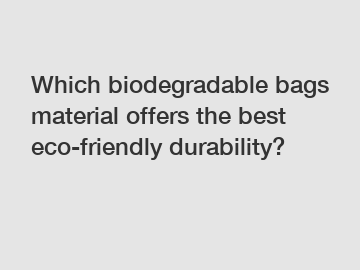Which biodegradable bags material offers the best eco-friendly durability?
Which Biodegradable Bags Material Offers the Best Eco-Friendly Durability?
In today's era of growing environmental concerns, the need for sustainable alternatives to single-use plastic bags has become increasingly important. Biodegradable bags, which are designed to decompose naturally and minimize harm to the environment, have emerged as a popular choice. However, not all biodegradable bag materials are created equal in terms of their eco-friendly durability. In this article, we will explore the different types of biodegradable bag materials and determine which one offers the best combination of sustainability and durability.
1. Polylactic Acid (PLA) Bags.

Polylactic acid (PLA) bags are made from fermented corn starch or sugarcane, making them fully biodegradable and compostable. PLA bags have gained popularity due to their renewable source material and ability to break down under specific environmental conditions. However, when it comes to durability, PLA bags may not be the ideal choice. They are prone to tear easily and do not withstand heavy loads, making them suitable only for lightweight items or short-term use.
2. Polyhydroxyalkanoates (PHA) Bags.
Polyhydroxyalkanoates (PHA) bags are derived from biological sources and are highly biodegradable. These bags are made by fermenting bacteria with organic matter like vegetable oils. PHA bags offer better durability compared to PLA bags as they are more heat-resistant and do not require specific environmental conditions for decomposition. However, PHA bags are still relatively expensive to produce and may not be widely accessible in all regions.
3. Starch-Based Bags.
Starch-based bags are another type of biodegradable bag material that offers a good balance of eco-friendliness and durability. These bags are primarily made from vegetable starch, usually derived from corn or potatoes. Starch-based bags are easily decomposed by microorganisms in the environment. They are generally stronger than PLA bags and can withstand heavier loads. However, excessive exposure to moisture can cause starch-based bags to lose their strength, limiting their durability in certain conditions.
4. Polybutyrate Adipate Terephthalate (PBAT) Bags.
PBAT bags are a blend of both petroleum-based plastics and biodegradable materials. While they are not entirely plant-based, they are designed to biodegrade under certain conditions. PBAT bags offer excellent durability and can withstand heavy loads, making them suitable for various applications. However, their reliance on petroleum-based plastics raises concerns about long-term sustainability.
In conclusion, the choice of the best biodegradable bag material with eco-friendly durability depends on specific needs and priorities. If the focus is on renewable resources and compostability, PLA bags made from corn starch or sugarcane may be a viable option. However, they lack durability and may not be suitable for heavy-duty purposes. If durability is a key consideration, starch-based bags or PBAT bags could be better choices, with starch-based bags offering better eco-friendliness. PHA bags also exhibit good durability, but their availability and cost may limit their widespread use.
Ultimately, finding the right balance between eco-friendliness and durability is crucial in determining the best biodegradable bag material for individual or business use. It is important to consider factors such as load capacity, moisture exposure, cost, and accessibility. By making an informed choice, we can contribute to reducing our environmental footprint and promoting sustainability.
For further inquiries or to explore more sustainable options, please feel free to contact us. Together, let's make a difference in safeguarding our planet for future generations.
If you want to learn more, please visit our website biodegradable bags manufacturer, compostable PBAT plastic For agriculture, is eco resin biodegradable.

Comments
0